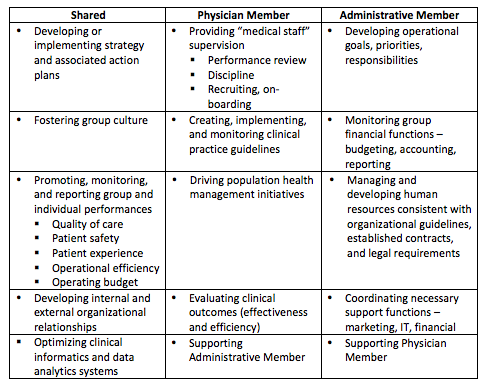Dyad management teams can be an extremely effective component of the management infrastructure as they ideally draw on the combined expertise of the clinical and administrative worlds to synergistically lead the organization or organizational sub-unit. However, merely creating the positions on the organization chart does not guarantee success.
What is a Dyad Management Team?
A dyad is literally defined as a pair. More specifically, a dyad can refer to two individuals maintaining a sociologically significant relationship – as in a marriage. (Miriam Webster)
In healthcare, a dyad consists of a clinical member, usually a physician, and an administrative member who co-lead or co-manage their area of responsibility. The idealistic basis of the model is a team-based approach to management in which the physician brings expertise regarding clinical operations and the administrator brings expertise regarding the business operations. Each of the dyad management team members directly contributes their strengths to organizational performance through well-defined, mutually supportive individual and shared responsibilities. While dyad management teams can be applied to various areas and levels across healthcare organizations, our description will focus on the employed physician enterprise.
What are the individual and shared responsibilities?
Although the exact responsibilities will vary based on the size and complexity of the organization or their assigned sub-unit, the dyad’s roles and responsibilities are often consistent with those outlined in the table below. Obviously, the list is not all inclusive but presents a conceptual overview.

Why pursue a dyad management model?
Traditional management structures are strictly operational with clear lines of authority driven by non-clinical administrators. Physicians (and other clinicians) did not have a formal role in the leadership hierarchy and were rather disengaged. Organizational change happened slowly – often against significant resistance.
Instituting a dyad management structure immediately injects physician leadership into the formal management hierarchy and engenders greater physician engagement in group operations. “Buy in” is accomplished as part of normal operations rather than being separately sought and striven toward. Trust in the system is enhanced and the group moves forward more effectively.
Of course, all management structures have inherent pros and cons. In the dyad structure, what is gained in alignment and engagement may be offset by a seemingly slower decision-making process and potential ambiguity regarding authority.
How can we foster success through dyad management?
Establish the structure. Before filling positions, ensure that the framework under which the dyad will function is in place. Clearly define the organizational structure, reporting relationships, and expected roles and responsibilities.
Recruit wisely. A successful pairing begins with the selection process. Key selection components go beyond possessing the requisite positional competencies to also evaluating the cultural fit with each other and the unit they will lead.
Clearly set functional expectations. The pair is expected to work synergistically to execute their well-defined roles and responsibilities. Instill the concept that they are a joint management team who share accountability for the unit’s performance and that their roles are complementary rather than duplicative. They are not two people doing the same job nor are they a “team” in which one member (administrator) does all of the work for review by the other (physician).
Train and mentor the physicians selected for these leadership roles. Clinical excellence is not enough. The selected physicians ideally aspire to a position/future in medical administration. Formal (specific courses, graduate education) and informal (independent self-study) educational elements should be pursued. Train and mentor the dyad pair in their relationship. Even if individually familiar with dyad concepts, consider formal and informal education combined with individual and paired coaching to promote successful function. If left to their own devices, the pair may devolve into separate worlds, rotating independently while revolving within a common central structure. If this occurs, dysfunction will be the likely outcome.
Educate the organization about the dyad’s roles and responsibilities, staff reporting relationships, and who should be approached with what issues. Explicitly defining these elements with staff sets realistic, practical expectations. Reliable execution fulfills the expectations and predicts success.
When properly implemented and executed, physician/administrator dyad management teams can have a profoundly positive impact on organizational success.
